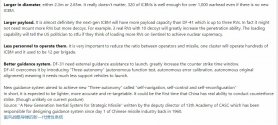I wonder if China’s warhead miniaturisation has faced hurdles because it was pressured into ceasing nuclear tests by 1996.of course actual research and development goes back to Jiang's time .. but major work has done during Hu Jintao time ..
if i remember correctly DF-41 get operational status in 2017 and officially unveiled to public during 70th National day parade in 2019.. it took time but not that much..
China appeared to lack both the supercomputers and other simulators that US national labs have, and the number of tests to generate the variety of data necessary for warhead stewardship and future designs. Of course this is relatively speaking. China’s data from its 45-47 tests (including a number of fizzled ones) could still help with stewardship of existing warheads (like the 535 on top of DF-31/41s, and the one on JL-2). However, despite talks of a new 575/shadow warhead tested after 1992 (those 90-95 kt yield tests), we don’t see evidence of the existence of a light warhead (something similar to the W-76) in service. It all appears that the 535 warhead (tested in 1992) is now the most numerous warhead in PLARF/PLAN service, forming the backbone of China’s nuclear force for decades to come.
However, China was actively trying to join the U.S.-led order in 1996, so ceasing nuclear test to sign the CTBT (but not ratify) was a necessary concessionary move. Now, given Washington’s changing stance on China since 2018, I wonder if this changing geopolitical environment could be an excuse for China to restart nuclear testing. The 2022 Pelosi visit to Taiwan could have been a great opportunity for China to jettison CTBT. If China, Russia, and the U.S. all abandons CTBT, China arguably has the most to gain since it needs more test data for future warhead stewardships and development of new weapons.

